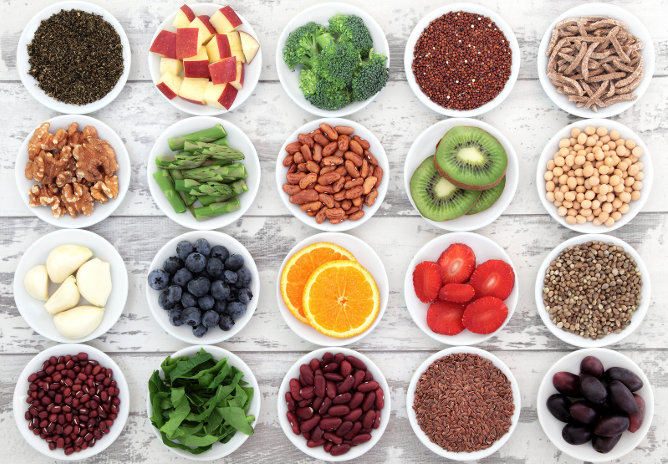Antioxidants Overview
The way to fight free radicals and reactive oxygen species is with antioxidants. An antioxidant is a substance that neutralizes free radicals. Specifically, it reduces oxidative damage.
Antioxidants are standard performance ingredients in skin care products. Some are also added to cosmetics to function as a preservative to prevent product spoilage. Vitamin E is an example.
Many fruits and vegetables, and other superfoods are natural sources of antioxidants. Antioxidants are also synthetically produced (for example, in supplements).
To show you some examples, I have pinned some beautiful pictures of antioxidant-rich foods on my Pinterest vitamin boards.
Direct vs Indirect Antioxidants
There are two different types of antioxidants.
The type you are probably familiar with is Direct Antioxidants – this is what you usually read about in the media.
What you may not know about is Indirect Antioxidants – this is more advanced information but valuable if you are serious about anti-aging.
1. Direct Antioxidants
Direct antioxidants come from outside sources, such as food or topical ingredients.
Since they are provided externally, they are also called Exogenous antioxidants (exogenous = external).
They donate electrons to free radicals, neutralizing them directly.
There’s another type of antioxidant, sometimes called a secondary antioxidant, that works by chelating metal ions.
2. Indirect Antioxidants
Indirect antioxidants work in a different way. Unlike direct antioxidants, indirect antioxidants do not bind to free radicals.
Instead they boost the body’s natural antioxidant defenses. They accomplish this in 3 ways:
- Boost the body’s detox enzymes (called Phase II enzymes)
- Recycle direct antioxidants
- Help cells produce antioxidant enzymes
Antioxidant enzymes are the body’s natural antioxidants. They are produced in a cell only when they are needed, such as when the cell is experiencing oxidative stress.
Because they are produced internally, Antioxidant Enzymes are called Endogenous antioxidants (endogenous = internal).
Examples of Antioxidant Enzymes:
- Superoxide Dismutase (SOD)
- Catalase
- Glutathione Peroxidase
Indirect Antioxidants are more effective than Direct Antioxidants. (More info about Indirect Antioxidants here)
For now, let’s just talk about Direct Antioxidants.
Why You Need Topical Antioxidants
Diet alone does not provide enough antioxidants for your skin. Antioxidants that you ingest from food or supplements get funneled to all parts of the body. The skin needs more in the face of a free radical assault (such as exposure to UV). Because free radicals are a never-ending assault, antioxidants are always needed.
Therefore, you need to apply antioxidants topically on the skin to mount an effective defense against free radicals.
There are many antioxidants. The most common are: Vitamins A, C, and E. They are also the most essential.
Popular Antioxidants in Skin Care
- Vitamin A (tretinoin, retinol, retinyl palmitate)
- Vitamin C
- Vitamin E
- Green & white tea
- Grape (resveratrol)
- Licorice
- Alpha Lipoic Acid (thioctic acid)
- Coenzyme Q10 (ubiquinone, Idebenone)
- Ferulic Acid
- Niacinamide (Vitamin B3)
- Beta carotene
- Lycopene
- Superoxide Dismutase
- Glutathione
- Zinc
- Acai
- Pomegranate
- Rosemary
- Turmeric
- Soy isoflavones
- and many more!
Many fruits, vegetables, herbs, and other plants contain pigments that provide antioxidant protection:
- carotenoids (beta carotene, lutein, lycopene, astaxanthin)
- flavonoids/bioflavonoids
- polyphenols
- curcuminoids
Antioxidants Are Quickly Oxidized By Light & Heat
You know how your cooking oil becomes rancid over time? And why oil should be stored in a dark, cool place away from sunlight? Because sunlight, heat, and oxygen oxidize the fat in the oil.
Same thing happens with skin care products. Once you open a jar or bottle, the antioxidant and lipid ingredients are exposed to oxygen, and the process of oxidation begins. This is why you need to throw out products after a certain period of time. They deteriorate and get rancid.
To help extend the life of your antioxidant products, store them in a dark, cool, dry place. Antioxidants degrade faster in light.
Also look for products packaged in airless pumps rather than traditional jars or bottles that open with a lid. An airless pump reduces a product’s exposure to oxygen and keeps it fresh longer.
The Strongest Antioxidants Are Unstable
The most powerful antioxidants are difficult to formulate because they are very hard to stabilize. Resveratrol, which is found in grapes, some berries, and Japanese knotweed (Mexican bamboo), is one of them. The higher the antioxidant potential (measured by the
ORAC score), the less stable it is in formula.
Essential Antioxidants
Highly Recommended Antioxidants

